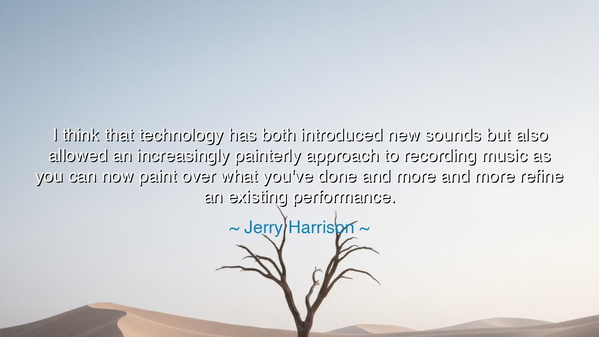
I think that technology has both introduced new sounds but also
I think that technology has both introduced new sounds but also allowed an increasingly painterly approach to recording music as you can now paint over what you've done and more and more refine an existing performance.






The words of Jerry Harrison, “I think that technology has both introduced new sounds but also allowed an increasingly painterly approach to recording music as you can now paint over what you've done and more and more refine an existing performance,” resound as a meditation on the evolution of creativity and expression through the lens of technological innovation. Harrison speaks not merely of instruments or equipment, but of the transformative power of technology to expand the palette of the artist, enabling musicians to sculpt, refine, and enhance their work with a precision once unattainable. In his vision, recording becomes a canvas, and sound itself becomes paint, each stroke contributing to the masterpiece of musical expression.
The origin of this insight lies in Harrison’s life as a musician and producer, both with Talking Heads and as a solo artist, where he witnessed firsthand how studio innovations—from multitrack recording to digital editing—revolutionized performance. In his era, technology allowed musicians not simply to capture sound, but to revisit it, layer it, and perfect it. Harrison’s reflection emphasizes that technology does not replace creativity, but magnifies it, giving artists the power to explore new textures, harmonies, and timbres while refining their original expression.
History provides a parallel in the evolution of the piano. When composers like Ludwig van Beethoven gained access to instruments with a broader range and dynamic capability, they could compose and perform works that were previously unimaginable. Just as Harrison notes with recording technology, the instrument itself expanded the possibilities of artistry. The new sounds created opportunities for refinement, experimentation, and expressive depth, illustrating how tools shape not only output but imagination itself.
Even more recently, the rise of digital audio workstations (DAWs) has transformed the studio into a laboratory of sound. Musicians can record multiple takes, experiment with effects, and layer tracks in ways that mimic a painter layering pigments on a canvas. Iconic albums, from Radiohead’s OK Computer to Beyoncé’s Lemonade, showcase this principle: the ability to refine, sculpt, and manipulate recordings has unlocked a new dimension of artistic control and creativity. Harrison’s insight captures this evolution, reminding us that the artist’s vision is enhanced, not replaced, by technological tools.
The meaning of his words is profound: technology serves as an extension of the artist’s imagination. It allows for exploration, refinement, and discovery within the creative process, transforming raw performance into polished artistry. Just as a painter can revisit a canvas, a musician can revisit a recording, layering nuance, correcting imperfection, and pushing expression beyond its original bounds. Harrison emphasizes that innovation in tools is inseparable from the evolution of creative expression.
The lesson for future generations is timeless: embrace technology not as a crutch, but as a partner in creation. Seek to understand the possibilities it offers, and use it to refine, enhance, and expand your artistic vision. Harrison teaches that mastery arises when the artist integrates tools with intuition, allowing technology to serve imagination rather than dictating it.
Practical action flows naturally. Experiment with the tools of your craft, whether musical, visual, or literary. Layer, refine, and iterate, viewing your work as a living creation that can evolve. Study the masters who have integrated technology into their expression, learning how they balance innovation with artistry. Encourage collaboration between technology and creativity, exploring how new methods can deepen, rather than dilute, the purity of expression.
Thus, let Jerry Harrison’s words endure as guidance for all creators: technology introduces new sounds and allows a painterly refinement of performance. By embracing innovation with discipline and imagination, artists can elevate their work, discovering richness, nuance, and beauty previously unimaginable. In this fusion of skill, vision, and technological mastery lies the promise of enduring artistry, inspiring generations to come.






AAdministratorAdministrator
Welcome, honored guests. Please leave a comment, we will respond soon